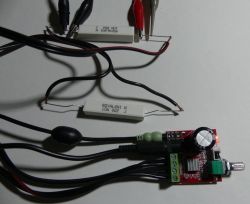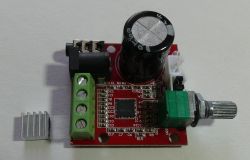Class D PAM8610 15V 2x10W amplifier module test
The amplifier module with PAM8610 has a power connector, terminals for connecting speakers, a minijack input and a volume control potentiometer. The kit includes a small heat sink to stick to the PAM8610 chip. Class D declared by the seller suggests energy efficiency, while the possibility of working at 12V may allow for power supply from a gel battery. Module to be found in online stores by searching for the phrase: PAM8610 .
The material is a continuation of the previous one with a similar amplifier module based on PAM8403 : https://www.elektroda.pl/rtvforum/topic3458041.html
When testing the PAM8403, it turned out that the circuit at the output generates "chaff", while the current consumption is increased when we connect the 8om resistor at the output instead of the loudspeaker (with measurable inductance).
After connecting the module with the PAM8610, it turned out that without the presence of an input signal in the speakers it is present noise louder than in PAM8403 . The attempt to listen to the music was successful, the quality is acceptable.
The module was powered with 15V, 8 ohm resistors were connected to the outputs. In the absence of an input signal, the output is quite clear, causing the noise mentioned above:


As with PAM8403, with PAM8610 the current consumption depends on the type of load (inductance).
If there is no input signal with disconnected speakers, the system uses 26mA,
connecting 8ohm speakers is 30mA consumption, connecting 8ohm resistors is 41mA, and with 4ohm resistors 44mA.
The differences in power consumption are much smaller than with the PAM8610.
The test system was powered with 15V, 8 ohm resistors were connected.

After giving the 1kHz signal, the familiar PAM8403 "chaff" appears on the output:

The output voltage of 2.8V at a resistance of 8 ohms corresponded to the output power of 2x1W,
current consumption at 15V was 0.423A, i.e. power consumption ~ 6.345W and efficiency ~ 32%.
2x5W power with an output voltage of 6.3V, required the delivery of 15V * 1.087A = 16.305W which gives the efficiency ~ 61% warm system.
Power 2x10W at a voltage of 8.9V on a resistor 8ohm, power consumption 15V * 1.731A = 25.965W which gives an efficiency of ~ 77%, the system is very warm.
The method of measurement is debatable, which was described in the previous material https://www.elektroda.pl/rtvforum/topic3458041.html
but the amplifier module is also unusual, the output signal is very different from a typical class D amplifier, eg TDA8932.
There are two jumpers on the board, one is closed (power on), the other is open (mute).
What do you think about the cheap PAM8610 amplifier module, where can it be used?
The material is a continuation of the previous one with a similar amplifier module based on PAM8403 : https://www.elektroda.pl/rtvforum/topic3458041.html
When testing the PAM8403, it turned out that the circuit at the output generates "chaff", while the current consumption is increased when we connect the 8om resistor at the output instead of the loudspeaker (with measurable inductance).
After connecting the module with the PAM8610, it turned out that without the presence of an input signal in the speakers it is present noise louder than in PAM8403 . The attempt to listen to the music was successful, the quality is acceptable.
The module was powered with 15V, 8 ohm resistors were connected to the outputs. In the absence of an input signal, the output is quite clear, causing the noise mentioned above:


As with PAM8403, with PAM8610 the current consumption depends on the type of load (inductance).
If there is no input signal with disconnected speakers, the system uses 26mA,
connecting 8ohm speakers is 30mA consumption, connecting 8ohm resistors is 41mA, and with 4ohm resistors 44mA.
The differences in power consumption are much smaller than with the PAM8610.
The test system was powered with 15V, 8 ohm resistors were connected.

After giving the 1kHz signal, the familiar PAM8403 "chaff" appears on the output:

The output voltage of 2.8V at a resistance of 8 ohms corresponded to the output power of 2x1W,
current consumption at 15V was 0.423A, i.e. power consumption ~ 6.345W and efficiency ~ 32%.
2x5W power with an output voltage of 6.3V, required the delivery of 15V * 1.087A = 16.305W which gives the efficiency ~ 61% warm system.
Power 2x10W at a voltage of 8.9V on a resistor 8ohm, power consumption 15V * 1.731A = 25.965W which gives an efficiency of ~ 77%, the system is very warm.
The method of measurement is debatable, which was described in the previous material https://www.elektroda.pl/rtvforum/topic3458041.html
but the amplifier module is also unusual, the output signal is very different from a typical class D amplifier, eg TDA8932.
There are two jumpers on the board, one is closed (power on), the other is open (mute).
What do you think about the cheap PAM8610 amplifier module, where can it be used?




Comments
A module like a module ... An amplifier like an amplifier. Nothing fancy except that it is small and cheap. The quality is not a sin because it is not designed for professional (audiophile) applications.... [Read more]
With this efficiency it is comparable to the old tda2003 where the sound quality at this voltage is better. These amplifiers have one major drawback. They have to work with the loudspeaker because of... [Read more]
Class D profit does not differ from AB in the maximum efficiency 100% vs 78%! Only from her character, which is little to talk about. The efficiency of the linear amplifier (AB) is proportional to its... [Read more]
Don't mix audiophilism with professionalism. Because it's like mixing religion with medicine. [Read more]
You could also think that when something is designed with an audiophile in mind, it becomes an audiophile product as a rule. :) Anyway, it is like that on the forums :) No matter what system it is important... [Read more]
I don't mix anything - I just pointed out that this particular circuit is what it is - very "medium" quality. So you can't expect super quality from him. [Read more]
So backlash :) Audiophiles will take it. The question of a good herb before the review and a correspondingly high price. [Read more]
If someone wants to describe his tests on the electrode and has an idea for a sensible use of the system, the possibility of testing, or want to get acquainted with this type of amplifier, I have 1 piece... [Read more]
Hello. Today I tried to replace the amplifier in the Polish boombox. Unfortunately, this amplifier generates some strange +15 and -15V single noise pins with and without load. All attempts to filter... [Read more]
Apart from the noise in the absence of the PAM8610 signal, there was no question of a cube explosion, the system worked stably (power consumption), with no signal, overdrive, presence and no load at the... [Read more]
The problem is that no one has reliably tested the module or even measured its basic parameters. And the fact that someone can not apply it, as a consequence of which the scalak exploded, has nothing... [Read more]
Why should I test? I bought it, I want to connect the power, speakers and it should work. I have no more dreams. [Read more]
Only that it is not a ready device that can be turned on by everyone. This is an electronic module that needs to be applied! All you have to do is loop the ground between the power ground and the signal... [Read more]
https://obrazki.elektroda.pl/6784649900_1525602690_thumb.jpg Please. It was enough to add simple RC filters to the outputs to show the audio waveform. The oscilloscope math function puts two waveforms... [Read more]
A simple module test developed into an interesting discussion and experimentation, I like that. What element values did you use in output filters? [Read more]
On each output 4k7 and 10nF to ground. Output to the oscilloscope with capacitors. Such values give the limit frequency of about 4khz, so they filter the carrier well, which is about 300khz, but you can... [Read more]
In the tested module, a potentiometer regulates the amplitude of the audio input signal. [Read more]
So this module with a single pot must regulate the voltage on the cutter volume and thus the volume but through the internal circuits of the IC. It is possible that this way the amplifier has less noise... [Read more]
Some calculations of these 100%, please. [Read more]